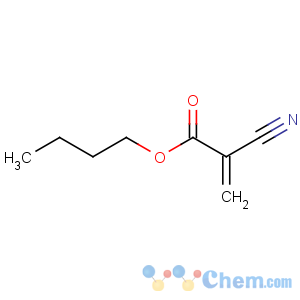Title: n-Butyl Cyanoacrylate
CAS Registry Number: 6606-65-1
CAS Name: 2-Cyano-2-propenoic acid butyl ester
Synonyms: enbucrilate; NBCA;
n-butyl 2-cyanoacrylate
Trademarks: Histoacryl (Braun); Indermil (Loctite); Liquiband (Medlogic); Tisuacryl (Centro de Biomateriales); Vetbond (3M)
Molecular Formula: C8H11NO2
Molecular Weight: 153.18
Percent Composition: C 62.73%, H 7.24%, N 9.14%, O 20.89%
Literature References: Monomer rapidly polymerizes upon contact with fluid or tissue to form a strong, biodegradable adhesive. Preparative methods: A. E. Ardis,
US 2467927 (1949 to B. F. Goodrich); C. H. McKeever,
US 2912454 (1959 to Rohm & Haas). Prepn, polymerization and degradation: F. Leonard
et al., J. Appl. Polym. Sci. 10, 259 (1966). Mechanism of polymerization and nanoparticle formation: N. Behan
et al., Biomaterials 22, 1335 (2001). Characterization of polymer nanoparticles by particle size analysis: A. Bootz
et al., Eur. J. Pharm. Biopharm. 57, 369 (2004); by MS:
idem et al., ibid. 60, 391 (2005). Clinical experience in ophthalmic applications: A. B. Leahey
et al., Ophthalmology 100, 173 (1993); in closure of surgical incisions: G. E. Amiel
et al., J. Am. Coll. Surg. 189, 21 (1999). Clinical evaluation in augmentation rhinoplasty: M. E. Sachs,
Arch. Otolaryngol. 111, 389 (1985); in management of bleeding gastric varices: B. D. Greenwald
et al., Am. J. Gastroenterol. 98, 1982 (2003). Review of biomedical applications: C. Vauthier
et al., Adv. Drug Delivery Rev. 55, 519-548 (2003).
Properties: Colorless liquid. bp1.8 68°. d20 0.989.
n20D 1.4424.
nD25 1.4410. Insol in water. Flash pt, closed cup: >176°F (>80°C). Vapor pressure (25°): <0.5 mmHg. Surface tension: 31.11 dynes/cm.
Highly reactive with water and weak bases.
Boiling point: bp1.8 68°
Flash point: Flash pt, closed cup: >176°F (>80°C)
Index of refraction: n20D 1.4424;
nD25 1.4410
Density: d20 0.989
Derivative Type: Polymer
CAS Registry Number: 25154-80-7
Synonyms: Poly(butyl 2-cyanoacrylate)
Use: Adhesive. Polymer nanoparticles as pharmaceutic aid for controlled release drug delivery.
Therap-Cat: Tissue adhesive.
Therap-Cat-Vet: Tissue adhesive.
Keywords: Tissue Adhesive.

